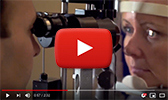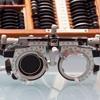Dry Eye Syndrome is a common eye condition that occurs from tear insufficiency or abnormality in the make-up of the tear film. While the tears are mostly made up of water, it is the mucinous and oily layers that provide stability to the tear film in between blinks. When there is an imbalance in this make-up, dry eyes may result. Symptoms of dry eyes include gritty, scratchy, irritated or burning eyes, a foreign body sensation, blurred vision and excess watering. Treatment options range from various over-the-counter artificial tears to prescription medications such as Restasis®, to various, procedures, such as the implantation of punctal plugs, intended to maintain the stability of the tear film. The doctors of Fifth Avenue Associates have established a systematic approach to addressing the signs and symptoms of Dry Eye Syndrome and follow patients closely to ensure successful management of their symptoms.
Dry eyes occur when the surface of the eye does not receive enough lubrication. This usually occurs as a result of either inadequate tear production or an imbalance in the make-up of tears. Age, eye or medical conditions and side effects to medications are common causes of diminished tear production. Also, environmental factors such as windy or dry climates may cause excessive evaporation of tears.
Tears are made up of three layers: water (for moisture), oil (to prevent water from evaporating) and mucus (for spreading the tears across the eye). Different glands near the eye produce the tear layers, so if a problem occurs with the production process of any of the glands, then dry eyes may result. For example, dry eyes often occur if the oily layer isn't adequate, causing the water layer to evaporate too quickly. Another cause may be if the mucus layer does not spread tears evenly across the eye. A common form of dry eyes is called keratoconjunctivitis sicca (KCS) and is caused by decreased production of the water layer in tears by the lacrimal gland.
Dry eyes are very common as we age, and are especially common in people over the age of 60. Also, women are more prone to dry eyes due to changes in hormone levels at different stages of their lives. Eye conditions such as inflammation or malposition of the eyelids may contribute to dry eye symptoms. Dry eyes may also develop as a result of refractive surgery or long-term contact lens use. Medical conditions such as diabetes, rheumatoid arthritis, lupus and thyroid problems can lead to dry eyes as well as certain medications such as antihistamines, blood pressure medications, oral contraceptives and antidepressants.
If you experience any of the symptoms of Dry Eye Syndrome, then an eye examination is an appropriate next step. During the exam, your doctor will take a history to determine if any of your symptoms are caused by an underlying medical condition, any medications you are taking or if an environmental factor may be playing a role. An external evaluation of your eyes will be performed to determine if the structure of your eyelids are contributing to your symptoms. Also, a test to measure the quantity and quality of tears generated may be performed.
While dry eyes are often not curable, the symptoms can be successfully managed. After evaluation, your doctor may recommend one of many types of over-the-counter lubricating drops (artificial tears) that replace the oily layer of tears to prevent water evaporation. Also, nutritional supplements such as omega-3 fatty acids may be recommended. If non-prescription remedies do not help, then Restasis®, a prescription product indicated to help increase tear production, may be prescribed. Another option for dry eye treatment is Lacrisert®, a tiny insert filled with a lubricating ingredient (hydroxypropyl cellulose). Everyday, the insert is placed just inside the lower eyelid, where it slowly dissolves and releases the lubricant throughout the day.
Depending on the severity and the cause of your dry eyes, your doctor may recommend punctal (lacrimal) plugs. Punctal plugs are tiny devices that are inserted in the tear drainage ducts to help keep tears from draining away too quickly. The plugs can be temporary or semi-permanent and may last from a few days to months. The plugs may be inserted into the lower eyelid, upper eyelid or both eyelids depending upon which tear duct(s) your physician deems necessary to block. Punctual plug insertion is a quick, painless, in-office procedure, and once in place, normally cannot be felt.
All of the doctors at Fifth Avenue Associates successfully manage dry eye patients and take either a conservative or aggressive approach to treatment depending upon the severity of the symptoms.
epiphora, punctal atresia, entropion, ectropion, exposure keratopathy, superficial punctate keratopathy, recurrent epithelial erosion, Meibomian gland dysfunction, blepharitis, conjunctivitis, Sjogrens syndrome
Dry Eye Management
Dry Eye Tears and Testing
Dry Eye: Treatments
Intense Pulsed Light (IPL) Therapy


Fifth Avenue Associates
1034 Fifth Avenue
New York, NY 10028
Phone: 212-570-0707
Fax: 212-570-0555
Email: [email protected]

Dry Eye Syndrome
Cataracts
Droopy Eyes
Bags Under The Eyes
Ptosis
Ectropion/Entropion
Eyelid Cancers
Refractive Surgery
Thyroid Eye Disease
Tear Duct Conditions
Pediatric Eye Care
Blepharospasm

For contact details and patient forms please click below.

Your gift can help Virtue Foundation tackle critical issues and make a positive impact around the globe.

Click here to view and listen to the latest Fifth Avenue Associates audio/Video Clips